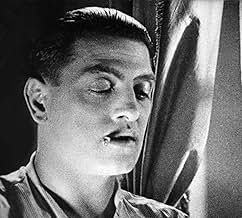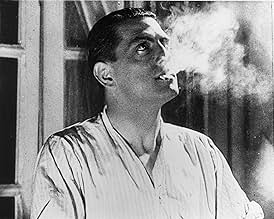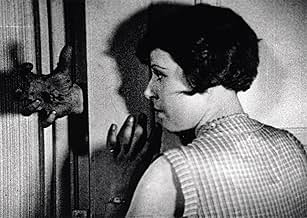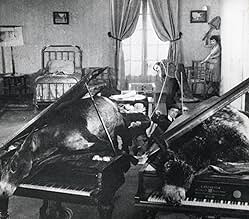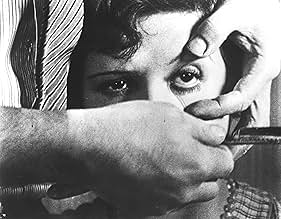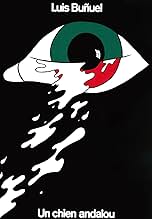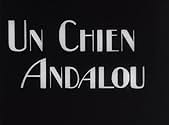IMDb रेटिंग
7.6/10
56 हज़ार
आपकी रेटिंग
अपनी भाषा में प्लॉट जोड़ेंLuis Buñuel and Salvador Dalí present 16 minutes of bizarre, surreal imagery.Luis Buñuel and Salvador Dalí present 16 minutes of bizarre, surreal imagery.Luis Buñuel and Salvador Dalí present 16 minutes of bizarre, surreal imagery.
Pierre Batcheff
- Man
- (as Pierre Batchef)
Simone Mareuil
- Young Girl
- (as Simonne Mareuil)
Luis Buñuel
- Man in Prologue
- (बिना क्रेडिट के)
Pancho Cossío
- Stroller
- (बिना क्रेडिट के)
Salvador Dalí
- Seminarist
- (बिना क्रेडिट के)
Juan Esplandiu
- Stroller
- (बिना क्रेडिट के)
Robert Hommet
- Young Man
- (बिना क्रेडिट के)
Marval
- Seminarist
- (बिना क्रेडिट के)
Fano Messan
- Hermaphrodite
- (बिना क्रेडिट के)
Jaume Miravitlles
- Fat Seminarist
- (बिना क्रेडिट के)
फ़ीचर्ड समीक्षाएं
I saw this recently n i am shocked at the violent content n nudity in a film made in 1929.
Candyman borrowed the scene where insects come out of a palm.
Candyman borrowed the scene where insects come out of a palm.
I find it hilarious that so many people who have posted here are even attempting to place any meaning whatsoever into this film's imagery! The only point to be made in this movie is that there should be no point to be made. Any significance placed onto anything contained in this film is a complete fabrication of the narrow-minded viewer who believes movies are only made to carry some message. That is the genius of Bunuel and Dali. They were surrealists. The point of surrealism is that there is no point, no meaning whatsoever.
Personally, you all may dissect (pun intended) and pore over this great film if you please, but you are fools in the eyes of the (deceased) filmmakers for doing so.
Personally, you all may dissect (pun intended) and pore over this great film if you please, but you are fools in the eyes of the (deceased) filmmakers for doing so.
Luis Buñuel, Calanda, in the province of Teruel in the south of the region called Aragón, a town itself afamed for the twenty-four hour non-stop drums (`la tamborada') in the streets played by hundreds of people together in Holy Week, as a young man fled to Paris with the intention of doing something great in this world. There he met Salvador Dalí who had done the same, leaving his native Catalonia in his mid twenties - some five years younger than Buñuel - with more or less the same ideas in his head.
These two young men, who in later years were to be known - even admired in some cases - as the most extravagant and flamboyant creators of art, were not alone. Pablo Picasso, not yet 50, had already been blazing the trail, to mention another Spaniard among those thronging the avant-garde Paris of the times. Claude Debussy and Maurice Ravel had led the impressionist movement in music for many years, and the `Imagiste' school in poetry was well under way. Anybody who was anybody in the artistic world flocked to Paris, and either made a hit and became someone eminent, or did not.
Cinema was a new art form still to be experimented with; no wonder, then, that these two men of evidently original ideas trying to burst out of them, had to do something so as to gatecrash into the gentry of the established circles of artistes and would-be artistes or hangers-on. The Buñuel-Dalí tandem knew they would produce something different; not necessarily to scandalize anyone, but more with the purpose of attracting attention, whether from intellectuals, artists or their entrepreneurs, or just newspaper editors. Simply following the logical sequence that words can be poetic and an image is worth a thousand words, and that poetry can be abstract, thus so can images, and if they move - better still.
Buñuel got a bit of money out of his mother's purse, and thus the two young men had finance to start on making an abstract poetic sequence which did not pretend to have any logical meaning of any kind. `Un Chien Andalou' was to exist in the same way that any later painting either by Picasso or by Dalí himself would exist without necessarily purporting to mean anything, either significant or insignificant, and without necessarily any implicit objective - far less objective - raison d'etre than simply existing in itself. Whether the result could or should be considered `art' in any quintessential sense is/was up to the pundits, pseudointellectuals, newspaper critics, or anybody else who thought he had any ideas on the matter. Buñuel himself says in his autobiography `My Last Breath' that he would have quite happily burnt the film, but that would not have made any difference anyway.
`Un Chien Andalou' was the only silent film he made; whether because of lack of funds or otherwise intentionally, is hard to say. `L'Age d'Or' one year later had sound; however I cannot help thinking that Buñuel and Dali wanted to make a silent film, which then does not explain why in the 1960s Buñuel chose to add music - Wagner interspersed with a tango, a blatently at-odds combination - which would seem to have been some attempt at being unfaithful to the original. But Buñuel was nothing if not a contradictory person, to say the least. But by the 1960s he was beginning to turn out his best repertoire - `Viridiana' (qv), `Tristana', etc - and maybe his sense of maturity reigned over his other feelings, compelling him to `up-date' the film for newer audiences, even though he might be accused of unloyalty.
But, how does one remain loyal to abstract concepts which defy rationality?
Thus `Un Chien Andalou' remains one of the most misunderstood pieces of art to have ever been made public, and is perhaps the most widely-known short film of all time.
These two young men, who in later years were to be known - even admired in some cases - as the most extravagant and flamboyant creators of art, were not alone. Pablo Picasso, not yet 50, had already been blazing the trail, to mention another Spaniard among those thronging the avant-garde Paris of the times. Claude Debussy and Maurice Ravel had led the impressionist movement in music for many years, and the `Imagiste' school in poetry was well under way. Anybody who was anybody in the artistic world flocked to Paris, and either made a hit and became someone eminent, or did not.
Cinema was a new art form still to be experimented with; no wonder, then, that these two men of evidently original ideas trying to burst out of them, had to do something so as to gatecrash into the gentry of the established circles of artistes and would-be artistes or hangers-on. The Buñuel-Dalí tandem knew they would produce something different; not necessarily to scandalize anyone, but more with the purpose of attracting attention, whether from intellectuals, artists or their entrepreneurs, or just newspaper editors. Simply following the logical sequence that words can be poetic and an image is worth a thousand words, and that poetry can be abstract, thus so can images, and if they move - better still.
Buñuel got a bit of money out of his mother's purse, and thus the two young men had finance to start on making an abstract poetic sequence which did not pretend to have any logical meaning of any kind. `Un Chien Andalou' was to exist in the same way that any later painting either by Picasso or by Dalí himself would exist without necessarily purporting to mean anything, either significant or insignificant, and without necessarily any implicit objective - far less objective - raison d'etre than simply existing in itself. Whether the result could or should be considered `art' in any quintessential sense is/was up to the pundits, pseudointellectuals, newspaper critics, or anybody else who thought he had any ideas on the matter. Buñuel himself says in his autobiography `My Last Breath' that he would have quite happily burnt the film, but that would not have made any difference anyway.
`Un Chien Andalou' was the only silent film he made; whether because of lack of funds or otherwise intentionally, is hard to say. `L'Age d'Or' one year later had sound; however I cannot help thinking that Buñuel and Dali wanted to make a silent film, which then does not explain why in the 1960s Buñuel chose to add music - Wagner interspersed with a tango, a blatently at-odds combination - which would seem to have been some attempt at being unfaithful to the original. But Buñuel was nothing if not a contradictory person, to say the least. But by the 1960s he was beginning to turn out his best repertoire - `Viridiana' (qv), `Tristana', etc - and maybe his sense of maturity reigned over his other feelings, compelling him to `up-date' the film for newer audiences, even though he might be accused of unloyalty.
But, how does one remain loyal to abstract concepts which defy rationality?
Thus `Un Chien Andalou' remains one of the most misunderstood pieces of art to have ever been made public, and is perhaps the most widely-known short film of all time.
this movie may be dated in a certain sense, but the vitality and passion of its vicious rebellion against societal taboos and constraints still comes through full throttle. bunuel, master of cinematic/surrealist revolt, violates every boundary he can think of. a woman's eyeball is slashed open, her chest brutally groped, ants crawl out of a man's hand, etc. this is more of a curiosity than anything else, but I am a surrealism fanatic and love this along with Cocteau's "Blood of a Poet". the reviewers here who downplay it's value are simply wrong and probably decided in advance to dislike it to look different.
I still remember my visit to Philadelphia Museum of Art, back in the April of 2005. One of the reasons I went there was to to see the Salvador Dali's exhibitions but the tickets were sold out. While in the museum, I was able to see two films that Dali was a big part of. In the video Gallery of the museum, two intriguing projects have been running together in the continuous loop, the early "Un Chien Andalou" (17 minutes) and the recently released, animated Destino (6 minutes). This was the first viewing for me. I kept coming back to the gallery few more times and I never was tired of both short films.
The inspiration for "Un Chien Andalou" began with the dreams of two young rebellious men, the artists and the friends, Luis Bunuel and Salvador Dali. They exchanged the dreams they both had, Bunuel - about a slender cloud slicing the moon in half "like a razor blade slicing through an eye", and Dali - about a dream involving a hand enveloped by ants. Both artists soon began working on a film script based on these ideas.
Made in 1929, the film has not aged at all. Its disconnected but haunting scenes and images are as shocking today (at least, for me they were) as I am sure they were all these years ago for the viewers who faced them for the first time. The reason the film is so powerful even now may be the themes of love, sex, death, and decay that are eternal and will always attract the artists and audiences alike. It is also could be in the establishing and following by both artists the certain rules, "No idea or image that might lend itself to a rational explanation of any kind will be accepted...We had to open all doors to the irrational and keep only those images that surprised us without trying to explain why." Perhaps, Dali and Bunuel intended their film to be experienced directly, on the visceral level, and not analyzed by the viewers.
The inspiration for "Un Chien Andalou" began with the dreams of two young rebellious men, the artists and the friends, Luis Bunuel and Salvador Dali. They exchanged the dreams they both had, Bunuel - about a slender cloud slicing the moon in half "like a razor blade slicing through an eye", and Dali - about a dream involving a hand enveloped by ants. Both artists soon began working on a film script based on these ideas.
Made in 1929, the film has not aged at all. Its disconnected but haunting scenes and images are as shocking today (at least, for me they were) as I am sure they were all these years ago for the viewers who faced them for the first time. The reason the film is so powerful even now may be the themes of love, sex, death, and decay that are eternal and will always attract the artists and audiences alike. It is also could be in the establishing and following by both artists the certain rules, "No idea or image that might lend itself to a rational explanation of any kind will be accepted...We had to open all doors to the irrational and keep only those images that surprised us without trying to explain why." Perhaps, Dali and Bunuel intended their film to be experienced directly, on the visceral level, and not analyzed by the viewers.
क्या आपको पता है
- ट्रिवियाAt the Paris premiere, Luis Buñuel hid behind the screen with stones in his pockets for fear of being attacked by the confused audience. Nothing of the sort happened. In fact, the audience loved its mysterious and incomprehensible plot.
- इसके अलावा अन्य वर्जनThe film was re-released in 1960 with soundtracks.
- कनेक्शनEdited into Avant-garde Cinema (1960)
टॉप पसंद
रेटिंग देने के लिए साइन-इन करें और वैयक्तिकृत सुझावों के लिए वॉचलिस्ट करें
विवरण
- रिलीज़ की तारीख़
- कंट्री ऑफ़ ओरिजिन
- भाषा
- इस रूप में भी जाना जाता है
- Un Chien Andalou
- फ़िल्माने की जगहें
- IMDbPro पर और कंपनी क्रेडिट देखें
- चलने की अवधि
- 16 मि
- रंग
- ध्वनि मिश्रण
- पक्ष अनुपात
- 1.33 : 1
इस पेज में योगदान दें
किसी बदलाव का सुझाव दें या अनुपलब्ध कॉन्टेंट जोड़ें


